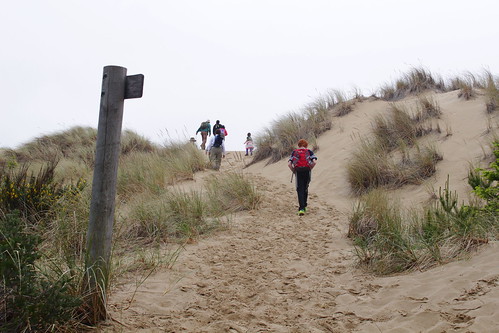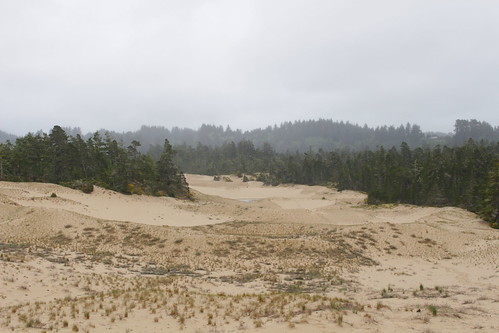Dellenback Dunes view from atop the "Great Dune"








Wildlife officials are investigating the death of a wolf in Wallowa County, in Northeast Oregon.
The body of OR-42, believed to be the breeding female of the Chesnimnus Pack, was recovered May 8, according to Oregon Department of Fish and Wildlife spokeswoman Michelle Dennehy. The finding was not announced until May 23. The wolf was wearing a GPS tracking collar; ODFW went looking for it after receiving a “mortality signal” from the device, Dennehy said.
A forensic examination did not pinpoint a cause of death, but ODFW said foul play, such as poaching, is not suspected “at this time.”
The case remains under investigation, however, and additional lab tests are being conducted by Oregon State University.
The Chesnimnus Pack has two subadult wolves that are wearing ODFW tracking collars.
EUGENE, Ore. (AP) — In a rare move, Oregon State Parks will auction off a 38-acre piece of property between Eugene and Corvallis with a stand of tall Douglas fir trees.
Once a wayside, or rest stop, along Highway 99 West near Monroe, the woodland will go up for sale this summer, according to State Parks spokesman Chris Havel. The agency more often trades land and rarely sells it outright.
“Right now, the market is such that we could really get some good out of it for the rest of the park system by putting it out for sale,” he said.
High levels of iron and nitrates in the groundwater at the site polluted the drinking water, and the septic systems at the wayside failed 10 years ago, the state said. State Parks then had the building torn down. Officials decided in 2012 to dispose of the land. They first offered it to other state agencies but found none interested.
So the agency is taking the uncommon step of offering the land for sale to the public through an auction, Havel said. State Parks will take bids this summer.
The land is worth an estimated $356,000, according to a January appraisal.
Since 2001, State Parks has disposed of 3,600 acres, with the last auction in 2008 when the agency sold a parcel at the Oregon State Fairgrounds in Salem. Havel said money from such sales goes into a fund used to buy land.
In the past 16 years, State Parks’ overall holdings have gone up from 93,000 acres to 108,000 acres.
Most of the land at the wayside, nearly 31 acres, is in Lane County and is zoned by the county for park and recreation use. The rest of the land, about 7 acres, is in Benton County and zoned for exclusive farm use.
Given that the property is outside any urban growth boundary and has restrictive zoning, it’s unclear what the land could be used for.
Harvesting the timber on the land is an option for the buyer, Havel said.
“That’s where most of the value is in the property,” he said. “It’s in those trees.”
The trees vary from a few dozen feet tall to 175 feet high, and the stand includes maple and ponderosa pines along with the Douglas fir.
The state bought the land in 1926 from William and Mae Washburne and long called it the Washburne Wayside, Havel said.
Motorists frequented the wayside more often before Interstate 5 became the main artery for longer trips.
“It was after I-5 went in and modern rest areas went in that use at that park started to drop pretty sharp,” Havel said.
NAMPA, Idaho — Researchers in the Treasure Valley area of Idaho and Oregon are trying to develop a reliable seed line for stevia, a plant that is 200 to 300 times sweeter than sugar.
Once that happens, the plant could be an attractive option for the region’s farmers.
But the plant likely won’t be grown commercially here until researchers learn how to reliably produce the small shrub from seed.
Stevia is used as a natural sweetener in drinks and food.
Unlike potatoes, corn and other crops that farmers have bred for hundreds of years, stevia has only been researched for about 50 years, said Cheryl Parris, research and development manager at S&W Seed Co.
Because of that, there is currently too much genetic diversity in stevia to grow it from seed, so it’s being grown from clones, or rooted cuttings, that are produced in a greenhouse and then transplanted into the field.
The labor and expense involved in growing stevia that way at 40,000 plants an acre makes it too expensive to be an attractive alternative to commercial farmers in the U.S., Parris said.
The company’s stevia research is centered in Nampa. Parris is trying to develop a reliable seed line that farmers can plant.
She said this is an ideal region for growing stevia. The company has received a lot of inquiries from farmers interested in growing stevia seed.
“There is a lot of variability in the plants because there is so much that hasn’t been bred out yet,” she said. “It will become more ideal as we develop a seed line. It’s still really an emerging market in the United States because of the cost at this point.”
The wide genetic diversity in stevia means the progeny is usually not as good as the parents, said Clint Shock, director of Oregon State University’s research station in Ontario.
“How to efficiently propagate stevia by seed hasn’t been solved,” said Shock, who has researched the plant for more than a decade. “In order for it to be competitive in the U.S., you need to be able to cross reliably and efficiently from seed. That is the Achilles heel of growing stevia in the United States.”
Most of the world’s stevia is grown in nations with much lower labor costs, Shock said.
“The competitive advantage now is for places that have super cheap labor,” he said.
Parris and Shock are also trying to breed out the sometimes bitter aftertaste associated with stevia.
“We’re trying to develop a plant that tastes better, doesn’t have a bitter aftertaste and can be used more as an additive to food products,” Parris said.
BEND, Ore. (AP) — Deschutes County finds itself in the middle of a marijuana tug of war just two and half years since Measure 91 legalized recreational marijuana in Oregon.
The Bend Bulletin reported Saturday that due to its unique farmland setup, and its restrictive, discretionary rules governing the growing of marijuana outside of city limits, Deschutes County is in the middle of battles over how, when and where plant owners can grow and produce the crop.
Deschutes County Commissioner Tony DeBone says rules established by the county in 2016 help balance the needs of marijuana growers looking to set up shop in rural parts of the county.
Both DeBone and Community Development Director for Deschutes County Nick Lelack say Deschutes County is open to revisiting its rules on marijuana production.
Azure Farms, the Sherman County, Ore., organic operation, faces a difficult and potentially expensive task to control the weeds that neighboring wheat farmers are complaining about.
Judit Barroso, a weed scientist at Oregon State University’s Columbia Basin Research and Extension Station in Pendleton, said she and other OSU experts are willing to help solve the problem that has simmered for years and boiled over this spring into a massive social media campaign that targeted county officials and a confrontational community meeting.
Barroso said the perennial weeds growing at Azure Farms are difficult to control, and it will take more than a single application or action to do the job. Because Azure Farms is organic, it would lose certification for three years if it attacks its weeds with the herbicides used by conventional farms in the area. Some local farmers believe the weed problem is so bad that Azure should spray, take its lumps with decertification and start organic farming again with clean fields in three years.
Dan Arp, dean of the College of Agricultural Sciences at OSU, said weed scientist Barroso will provide “evidence-based information with regard to what may or may not work” to control the weeds. The help could include information on treatment methods and weed seed transmission, he said.
“We don’t design management plans,” Arp said. “This clearly is a county issue, the county has authority. They’re the ones who have to approve the plan.”
“It’s an interesting example of the issues around co-existence,” Arp said.
At a Sherman County Court hearing last week in the local high school gym, Azure Farms principals David and Nathan Stelzer presented a plan to control Rush Skeleton, Canada Thistle, White Top and Bindweed growing on their 1,922-acre farm on the outskirts of Moro, the county seat. An estimated 300 people attended, more than one-sixth the county’s population.
The county court had warned it would ask the Oregon Department of Agriculture to quarantine the farm if it did not control its weeds. Other farmers, especially those who grow certified wheat, don’t want weed seeds spreading from Azure Farms to contaminate their crops.
Tim Butler, who manages the ODA’s noxious weed program, said the ag department supports Sherman County’s action. “Our mission is to protect Oregon’s natural resource and agricultural economy from invasive, noxious weeds,” he said. “These things have impact directly on ag.
“I think Sherman County is doing the right thing for the right reasons, for sure,” Butler said.
He said a quarantine for weeds has been used only one time in Oregon that he recalls. The weed management plan submitted by Azure Farms “still needs some work” but is on the right track, Butler said.
“That’s where the weed scientists at OSU can provide some insight,” he said. “I think they can get there.”
The Stelzers, who are brothers, proposed a variety of methods, including deep tillage, mowing, increased crop rotation, over-application of fertilizer and application of such things as boron, salt and citrus pulp mulch. Nathan Stelzer is the farm manager; David Stelzer is CEO of Azure Standard in Dufur, Ore., which distributes organic products.
Bryan Cranston, who grows certified wheat next to Azure Farms, said he hopes the Stelzers, neighboring farmers and county officials can find a solution that works for everyone. “I don’t want them to lose organic certification, I don’t,” he said.
But Cranston also said the time for experimental weed control methods has passed. He believes the only way to control Rush Skeleton weed in particular is with the herbicide Milestone, which is not certified for use on organic operations.
Like many in the county, Cranston was angry the farm used social media to rally customers and organic activists to its side. County officials received approximately 57,000 emails, many from people who angrily denounced the county for what the senders characterized as threatening to poison the farm with herbicides. The county courthouse had to shut down its phone system, because it was overwhelmed. Some critics invoked the specter of Monsanto, which had no discernable role in the matter.
During the Sherman County Court session, Cranston and others made it clear they didn’t appreciate it.
“Noxious weeds spread the same way something is viral on Facebook,” he said during the hearing. “I would appreciate a visit over a tailgate, not a social media campaign.”
During the meeting, David Stelzer apologized for taking the issue to social media.
Speaking this week, Cranston said weeds from Azure have been a problem for 10 years, and he’s frustrated many people are acting like the problem was discovered only recently. He hopes the county will supervise Azure’s progress on its weed management plan, and he believes the organic farm should pay for it.
Willamette Valley farmer Marie Bowers, who grows grass seed and turnip seed, also said co-existence between farmers is the key issue. In her case, she has a turnip field next to wine grapes. She and the vineyard operator notify each other when they need to spray, for example, and time their work so it doesn’t harm the other.
“You want to be respectful of your neighbor, you want to work together,” she said. “That’s part of what we do in Oregon: We check with each other.”
Bowers said the non-farming public may not understand weed control is important to farmers, especially those growing seed. Seed purity, providing a product that is free of weeds, is “pretty much vital to our industry,” she said.
COLFAX, Wash. — The Snake River Family Festival on May 20 celebrated the billions of dollars in economic contributions the Columbia-Snake River system makes to the Pacific Northwest economy.
More than 400 people attended the festival at Boyer Park and Marina in Colfax, Wash. It included free food, children’s activities, live music, an information tent, an interactive salmon display, farm machinery and barge and tug boat displays.
The entire system represents $20 billion of commerce, said Tom Kammerzell, commissioner for the Port of Whitman County and a Colfax rancher.
Nearly 10 percent of all U.S. wheat exports move through Snake River dams, and more than 4.3 million tons of cargo was barged on the Snake River in 2014. It would have taken 167,000 semi-trucks or 43,000 rail cars to carry that amount.
Rob Rich, vice president of marine services for tug and barge operator Shaver Transportation Co., said the river system impacts farmers, grain elevators, fertilizer and seed providers, ports, towboat operators, cruise vessels and electricity and irrigation users.
With the system, Rich said, farmers have a bulk transportation system not affected by weather.
Export elevators downriver receive 40 percent of the wheat by barge and 60 percent by rail.
About 80 percent of farmers using the river system are solely dependent on it, Rich said.
“Where they are sending their wheat, that particular elevator only has the opportunity to receive by truck and ship by barge,” he said.
A typical four-barge tow moves the same amount of cargo as 140 rail cars or 538 trucks.
Trucks are more expensive per ton, so farmers wouldn’t be as competitive in the export market, Rich said.
The current rail capacity isn’t sufficient to meet current or projected wheat transportation needs, according to the committee.
Without the river system, the economic picture would be “bleak,” Kammerzell said.
Chad Crosby of Lewiston, Idaho, is not connected to the industry, but fishes and boats on the river.
He said he was interested in learning more about how the dams produce electricity and in some of the products he sees shipped on the river.
“Educate these young minds,” he said, watching his children participate in activities in the information tent.
Linhda Sagen of Pullman, Wash., said she used to work for the USDA wheat laboratory and researched barley. She and her family were impressed by the displays.
“We forget where our food source is coming from,” she said. “If we didn’t have the dam to transport wheat, (it would mean) essentially farmers going out of business.”
Beth Hegde, senior account director of public relations agency Desautel Hege in Spokane, said rain at the beginning of the event might have initially reduced attendance.
“We’re very happy that once the morning weather cooperated, we had a really good turnout,” Hegde said. “This event was really successful, so we would surely like to think about one for next year.”
| S | M | T | W | T | F | S |
|---|---|---|---|---|---|---|
|
|
|
|
|
3 |
4 |
5 |
|
6 |
7 |
8 |
|
|
11 |
12 |
|
13 |
14 |
15 |
|
17 |
18 |
|
|
20 |
21 |
22 |
|
|
25 |
26 |
|
27 |
28 |
29 |
|
|
|
|
Select the newsletter(s) to which you want to subscribe or unsubscribe.